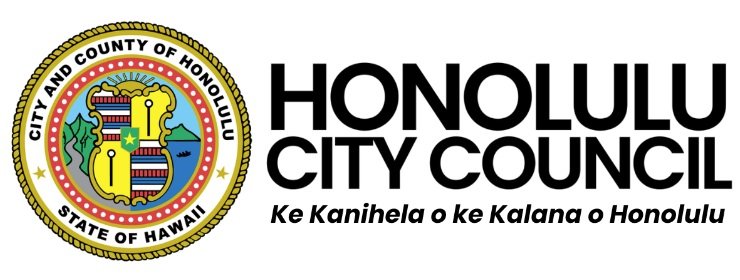Council Advances Tourist Accommodations Tax
Revenue to be used for critical public services, transit infrastructure, and protecting parks
HONOLULU, HAWAI‘I ̶ The Honolulu City Council voted today to advance Bill 40, which would authorize the City and County of Honolulu to collect a three percent tax on hotel stays and visitor accommodations, following similar moves by Kauaʻi County and Maui County. The state legislature passed House Bill 862, withholding all Transient Accommodation Tax (TAT) annual revenue from the counties, which has caused budget shortfalls at the local government level.
However, the legislature provided the authority to all four local county governments to levy their own TAT of up to three percent to make up for revenue lost to the state. The City and County of Honolulu lost approximately $45 million in TAT revenue per year in the wake of the law.
“Bill 40 will ensure that visitors pay their fair share of mitigating the impacts of tourism on our public facilities, including restoration and maintenance of beaches and parks, by using a percentage of TAT collections,” said Honolulu City Council Chair Tommy Waters. “One bright spot we saw with the pandemic was a rebound in the health of our beaches, trails, and natural environment—and this bill will make sure our visitors pay more to protect our island home. I also made a promise to my constituency that I would not use their real property taxes to fund the construction of the rail line, and I intend to keep that promise. I therefore look forward to hearing from HART and other community stakeholders about the viability of passing any costs onto tourists to save our locals from bearing the tax burden.”
Mayor Blangiardi also voiced strong support for Bill 40 and the imposition of a three percent TAT in his testimony to the Council today. “As Mayor, it is my responsibility to make sure the City has the financial resources necessary to maintain core City services and provide for the needs of residents and visitors alike,” he said. “I support a City version of the TAT to restore a revenue base which has been lost – allowing us to continue services to our people. I am committed to a functional rail project and delivering expanded transit service to our communities. However, if the numbers do not make sense, the strategy does not make sense.
Right now we do not have the numbers to discuss a specific allocation for rail. I look forward to working with the City Council, getting additional financial information from HART for construction and DTS for interim rail operations, and making informed decisions as we go through the public hearing process on Bill 40.”
City Council Budget Chair Calvin Say voted to advance the measure to his committee and shared the importance of establishing a three percent TAT to ensure fiscal responsibility for the City Budget. “While filling a $45 million hole puts us in a difficult position, I am grateful that the state legislature gave local county governments the opportunity to diversify our revenue sources and establish our own TAT rate,” he said. “I look forward to discussions in our Budget Committee about how to make the City Budget whole and responsibly allocate these funds for critical needs on our island.”
Bill 40 directs that the 3 percent tax—which could amount to approximately $7 million per month in revenue—will be divided between parks and natural area support, the City transit fund to support the Honolulu rail project, and the City’s general fund which supports police, fire, and rescue costs among other expenses. Bill 40 does not yet define how much revenue would go to each, and the Council will have an opportunity to determine these dedicated amounts in future hearings. TAT funds to support rail would help the City Council hold the line against using any additional property tax revenue for the project, as well as address Honolulu’s housing crisis.
Housing developers agreed with the move to dedicate TAT funds as well. “With a dedicated portion of the TAT going to the transit fund, it allows us to develop mixed-use, mixed-income, transit-oriented development that will serve the entire housing ladder, together with neighborhood retail and service amenities,” said Stanford Carr, President of Stanford Carr Development. “Tens of thousands of housing units could be built along the route. To build affordable housing for Oʻahu, we need a stable source of funding to finish the rail project and link these communities together.”
Bill 40 would also advance an idea that has been discussed for years at the state level, to ensure that visitors pay more to support natural resources, but that has yet to materialize. “This is a major step forward, and one that many organizations have been advocating for,” said Jack Kittinger, Vice President at Conservation International. “The idea of a ‘green fee’—essentially making sure that visitors directly support the natural environment that residents and the tourism sector both rely on—is critical to long-term sustainability. Bill 40 could turn promises into progress at the county level.”
Several other community organizations such as AARP Hawaiʻi, Hawaiʻi Appleseed Center for Law & Economic Justice, and Move Oʻahu Forward submitted testimony in support of Bill 40 and for dedicating a portion of TAT revenue to support the completion of the rail project. The full list of testimony can be found at: https://honolulu.granicus.com/MetaViewer.php?view_id=3&event_id=825&meta_id=205751.
The move to increase the tourism tax is aligned with an approach that would focus on reducing the overall amount of visitors to the island while increasing the amount of spending per visitor to benefit the local economy. The County of Kauaʻi imposed its 3 percent TAT effective October 1, and Maui County passed Bill 101 unanimously on October 1 to implement its own 3 percent increase. The Hawaiʻi County Council is also preparing an effort to restore lost TAT revenue with its own transient accommodations tax.
Bill 40: https://hnldoc.ehawaii.gov/hnldoc/document-download?id=12118
